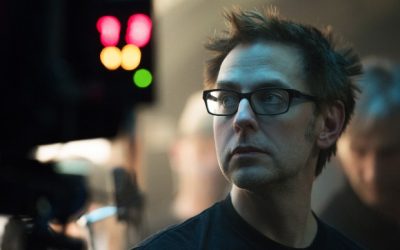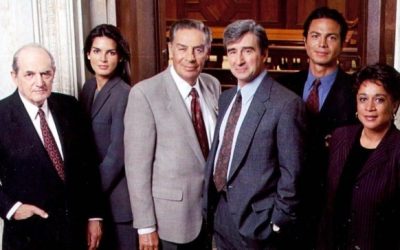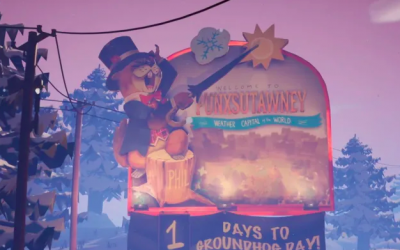
If Beale Street Could Talk review: operatic, intimate and passionate
Writer/director Barry Jenkins has followed Moonlight with another masterpiece. Here’s our review…
“Every black person in America was born on Beale Street, in the black neighbourhood of some American city” says the opening epigraph at the beg…
If Beale Street Could Talk review: operatic, intimate and passionate
Writer/director Barry Jenkins has followed Moonlight with another masterpiece. Here’s our review…
“Every black person in America was born on Beale Street, in the black neighbourhood of some American city” says the opening epigraph at the beg…
If Beale Street Could Talk review: operatic, intimate and passionate
Writer/director Barry Jenkins has followed Moonlight with another masterpiece. Here’s our review…
“Every black person in America was born on Beale Street, in the black neighbourhood of some American city” says the opening epigraph at the beg…
Velvet Buzzsaw review: a horror-satire that lacks real bite
Dan Gilroy’s macabre Netflix hybrid is decent enough, but fails to match the fierce intensity of Nightcrawler
Velvet Buzzsaw offers a new glimpse at the sub-genre of haunted-art horror, which otherwise may have reached its popular zenith with 1989’s Ghostbusters II.
After an opening scene at a Miami Beach art conference where we’re introduced to the ridiculous, self-regarding and pretentious players of the US gallery scene, writer/director Dan Gilroy’s tonally askew satire-horror heads to Los Angeles and stays there.
Jake Gyllenhaal, arguably Hollywood’s chief pick for portraying intense, intelligent, white oddballs under 40, leads as the terrifically named art critic Morf Vandewalt. Rene Russo plays hard-nosed art gallery owner Rhodora Haze (another top-drawer name), while Zawe Ashton is Josephina, a fledgling agent employed by Haze and desired by Vandewalt. Before Vandewalt wins the affections of Josephina, he’s shown lounging nude while a naked man wanders his apartment in conversation with him. Vandewalt’s potential bisexuality is never referenced again.
When Josephina discovers a dead man named Vetril Dease in the hallway of her apartment block, she pokes around in his home, finds his paintings and steals them to show Vandewaltz and Haze. The pair love what they see and, with the patronage of two such influential figures, there’s soon a clamour for Dease’s work. As the wider industry gets wind of Dease, assistants and others working around his art start dying in mysterious circumstances.
The influence of giallo has become common in recent years, with the work of filmmakers such as Peter Strickland paying tribute to classic Italian horror directors. Then in 2018, Luca Guadagnino went a step further and remade Dario Argento’s Suspiria, with mixed results. Velvet Buzzsaw is most reminiscent of Argento’s 1970 giallo touchstone The Bird With The Crystal Plumage, most overtly because of its gallery setting and murder but particularly for its overall feel of menace and atmosphere of dread.
There are certainly some fine jump scares and satisfyingly bloody deaths. The grisly fate of one supporting character provides the film’s best comic moment: a corpse is mistaken for art and left in the middle of a busy gallery while children stomp around in its congealed pools of blood.
Anticipation for Velvet Buzzsaw was through the roof when it was announced that Gilroy, Gyllenhaal and Russo were reuniting, their previous collaboration yielding the sinister treats of 2014’s Nightcrawler. That film offered a damning assessment of LA’s TV news business and featured savage turns from Gyllenhaal and Russo. The art world’s pomposity is punctured here and the two actors once again have fun playing two people one would not want to get stuck talking to at a party. Elsewhere, Toni Colette and John Malkovich have small, fun roles as a grasping assistant and a creatively blocked artist respectively.
But Velvet Buzzsaw suffers slightly from being not quite depraved enough. Death scenes notwithstanding, there seems to be a reluctance from Gilroy to really push the film’s visual strangeness, which is sometimes lurid and unusual (melting paintings and what appear to be monkeys leaping around inside a mirror are two demented highlights) but used too sparingly. It’s as if the actors are being allowed full intensity in their performances but the film as a whole isn’t. In trying to be both horror and satire, has slightly fallen between two stools – to its detriment.
Velvet Buzzsaw is a solid take on a glamorous, aspirational part of the culture industry from Gilroy and makes an interesting companion piece to Nightcrawler. But those who prefer their contemporary LA satire more extreme may prefer David Cronenberg’s Map to The Stars (2014) or Nicolas Winding Refn’s The Neon Demon (2016).
James Gunn was reportedly offered choice of DC properties
Kirsten Howard
Feb 4, 2019
According to a new report, James Gunn was offered his pick of DC properties before choosing Suicide Squad…
James Gunn’s Superman? James Gunn’s Hawkman? Can you picture it? Mm, we ca…
How long-running shows mark milestone anniversaries
Juliette Harrisson
With Supernatural’s 300th episode approaching, here’s how some of the most successful dramas have celebrated big birthdays…
Supernatural is about to join an elite group of scripted live action shows – those that have produced 300 episodes of television. Here, we celebrate some of those shows and the episodes they produced to mark milestones along the way.
We’re looking at scripted, live-action Western English-language shows aimed at general or adult audiences only (no soap operas, game shows, children’s cartoons, panel shows etc.). Both The Simpsons and Family Guy have run for well over 300 episodes and both have found innovative ways to celebrate them, but that’s another topic for another day.
Law & Order
Law & Order has a simple hook. The first half of each episode is a simple crime drama, following detectives solving a crime. However, rather than stop there, the second half of each episode shows us the court case – so the episode’s tension hinges not just on whodunnit, but whether justice will be served or not. The series aimed to be as realistic as possible within the confines of television drama, and often featured stories inspired by headline news.
While many of the scripted dramas we’re looking at have heavy soap opera style elements and arc plots relating to the relationships between characters, one thing many of them have in common is a core structure based around standalone episodes and stories told over just one hour (45 minutes if you take out the adverts). This means that viewers can dip in and out of the show if they choose to – they might miss some of the details of the characters’ relationships and development, but anyone can follow the basic story of any episode without needing to know the background. This means that new viewers can join in at any time, viewers who had drifted away from the show can come back to it, and viewers with busy lives can dip in and out without having to spend time catching up on every single episode. This is part of the key to Law & Order’s success, and on of the reasons its spin-off series Law & Order: Special Victims Unit has reached more than 400 episodes as well, and is still going.
100th episode: Law & Order didn’t really go in for celebrating milestone episodes, and several are fairly basic instalments of the show. In this 100th episode, a former Catholic priest is involved in the murder of an abortion doctor; based on the real life case of former Presbyterian minister Paul Jennings Hill.
200th episode: A man kidnaps is two children after being denied custody and has entirely controlled their lives and brainwashed them – a rather depressing episode.
300th episode: The team investigate multiple crimes on the same day – this is a bit more out of the ordinary, but it was a format they’d already used in an earlier Season 4 episode.
400th episode: The team investigate a con artist. The Law & Order team really don’t go in for celebrating milestone episodes. Law & Order: Special Victims Unit made a bit more effort with their 200th episode, which guest-starred Robin Williams, but that’s about it.
Original cast members in the 300th episode: None.
Probably jumped the shark when: Jerry Orbach left, shortly before his death from cancer.
CSI: Crime Scene Investigation
CSI is basically a cop show with a pseudo-scientific spin. Technically it’s not science fiction and anything featured in the show should be possible in reality, though anyone involved in forensic science – or any branch of science – will quickly tell you that it strays into the realm of fantasy more often than not. Still, while the method of detecting the crimes relies on sometimes fantastical forensic science, it remains at its heart a simple, fairly straightforward cop/detective show, with on-going story arcs surrounding the main characters and a Case of the Week format.
Cop shows are one of the two most promising genres you can make if you want a long-running series. By having the cast solve a new mystery each week, you keep audiences hooked for the duration of the episode, and keep them coming back for more on the promise of more mysteries to solve. The show can tackle a reasonably wide variety of subject matter, and CSI has often highlighted particular subcultures, special interest groups, careers and so on over the course of its stories (not always in a flattering way, considering it’s a crime drama!). Create a compelling enough main character or two and write some decent mysteries, and you’ve got a show that will run and run. And spawn half a dozen spin-offs. And then run some more.
100th episode: The team investigate the murder of a transgender woman. This one is really just a standard episode.
200th episode: A former student of Langston’s is murdered near a Mexican wrestling ring. This one makes some effort, with a victim connected to a principal character, and a special guest director, William Friedkin (director of The Exorcist) returning to direct a second episode following Season 8’s Cockroaches.
300th episode: The team investigates a cold case, and flashbacks show former main character Catherine Willows along with other team members from the era the show first started. The number 300 also appears at various points throughout the episode, and clips from earlier episodes were shown at the end.
Original cast members in the 300th episode: Paul Guilfoyle, Jorja Fox, Greg Sanders, Al Robbins, and Marg Helgenberger returned to guest star in the 300th episode.
Probably jumped the shark when: Grissom left in Season 9.
NCIS
NCIS (Naval Criminal Investigation Service) is a spin-off from JAG (Judge Advocate General), both created by US Marine Corps veteran (and Quantum Leap creator) Donald P. Bellisario. One of Bellisario’s skills as a writer is his ability to combine what is clearly fantasy with a grounded feeling. In his science fiction work, the elements of fantasy are more obvious; in his non-science fiction work, not unlike in CSI, the fantasy element consists of incidents that tend to be far more exciting than the day to day reality of the job depicted. Bellisario’s own experience in the Marine Corps in the 1950s allows him to ground these shows in just enough reality to make them feel real, while allowing the demands of television drama to enhance, enliven and shake them up.
JAG (very popular, but not quite as long-running as NCIS) had a format similar to Law & Order with a focus on courtroom drama but in the navy (something Bellisario had already explored in his Quantum Leap episode A Leap For Lisa). NCIS, however, follows civilian agents responsible for investigating crimes involving the navy. This means it follows a more traditional cop show format, which (like CSI) partly explains its longevity. NCIS also includes plenty of humour, which helps to keep audiences tuning in week after week. Mystery + unusual setting + humour = big success.
100th episode: Bit of an odd one, this – the 100th episode to air was Chimera, in which the team investigate a top secret research ship abandoned and left with one dead body on it. However, the episode intended to be the 100th was Requiem, in which Gibbs is visited by a childhood friend of his late daughter, and has a vision of his deceased wife and daughter while unconscious. The episodes were switched around because the 100th episode would air on October 30th and it was felt that Chimera was more suitable for Halloween.
200th episode: Gibbs is shot and his life flashes before his eyes, as well as an alternative future. This is classic celebratory milestone episode stuff, allowing for the return of departed cast members (including those whose characters had been killed off) and lots of character work for the show’s lead.
300th episode: The team must question a marine suffering from PTSD who is the sole survivor of an ambush during which a long distance sniper rifle was stolen. Although the main characters in NCIS are civilians, the show is based around the military, so it was good to see the show highlight a real military programme for helping veterans in a moving episode.
Original cast members in the 300th episode: Mark Harmon, Michael Weatherly, Pauley Perette, David McCallum.
Probably jumped the shark when: NCIS has shown an unusual ability to hang on to core cast members for a long period of time, but a couple have left over recent years, leading some viewers to feel the show is no longer the same.
ER
The other prime candidate for a long-running show is a medical drama, and ER is the quintessential medical drama. Like CSI, the series would highlight various subcultures and special interest groups from time to time. Each episode would cover several medical cases with reliably unpredictable outcomes – if audiences weren’t convinced that anyone could die by the attempted suicide of a major character in the pilot episode, the Season 1 episode in which a mother and baby both die in labour will have driven the message home.
Meanwhile, long-term viewers were hooked by the soap opera side of the show, with long-running storylines between various characters, dealing with romance, family life, dealing with the pressures of the job and so on bringing audiences back year after year. Although the cast turnover was fairly high, the cast was large enough that despite major high profile departures, there was a decent likelihood that there was at least one character remaining the viewers were interested in.
100th episode: The hospital invites its oldest living patient, who was born there 100 years earlier, for a tour to celebrate its centenary.
200th episode: Carter has a bad day but Pratt has a better night, and the two stories are spliced together in an innovative bit of formatting.
300th episode: The ER treats 300 patients in one day. The ER writers really liked to play with numbers in these episodes – and of course, the 300th patient ends up being a recurring character (Frank).
Original cast members in the 300th episode: None, though Yvette Freeman had been a recurring character since Season 1 and is in the 100th, 200th and 300th episodes.
Probably jumped the shark when: Of course, for a lot of people, the show was never the same after George Clooney left, others hung on until Julianna Marguiles left the following year, but one of the more popular opinions is that it really started to decline after Anthony Edwards’ departure in Season 8.
Grey’s Anatomy
Grey’s Anatomy is a bit like ER on steroids. It’s a medical drama with a heavy focus on the personal and romantic lives of the main characters, but with the ‘medical’ side of the medical drama scaled back a bit and everything else scaled up, though it’s a little less out there than it used to be. There probably won’t be another running storyline about a woman hallucinating her dead fiancée, including having intimate relations with him. We think.
Essentially, Grey’s Anatomy is as close to soap opera as scripted drama gets, and it keeps going for the same reasons as long-running soap operas. People get attached to characters they like and enjoy following their story, while the sometimes melodramatic storylines and unpredictable plot developments keep things interesting.
100th episode: Meredith and Derek are supposed to get married, but when Izzie is diagnosed with an inoperable brain tumour, they give her and Alex their wedding. High soap opera drama was entirely suitable for this show’s 100th episode.
200th episode: The doctors throw a fundraising gala – essentially, everyone has a big party. So, pretty appropriate for a celebratory episode.
300th episode: Easter eggs for fans were hidden throughout the episode – most prominently, the doctors treated patients who reminded them of departed cast members, and Meredith saw a vision of her mother after winning an award.
Original cast members in the 300th episode: Ellen Pompeo, Justin Chambers, Chandra Wilson, James Pickens Jr.
Probably jumped the shark when: Of course the killing off of McDreamy lost a lot of viewers, but many others would say the rot set in earlier than that, perhaps as early as Season 6.
Doctor Who
Do we need to introduce Doctor Who and explain it to the readers of Den of Geek? No, I didn’t think so! As we all know, the show’s ability to tell stories set anywhere in time and space and to have its lead character entirely change their appearance and gender makes it pretty much evergreen.
Being British, Doctor Who doesn’t celebrate episode milestones, but rather anniversaries of 10, 20, 30 years and so on (incidentally, the tenth episode of the serial Day Of The Daleks is the 100th episode of Classic Who, while The Crimson Horror is the 100th episode of New Who).
These are nearly always multiple Doctor stories, in which timey-wimey shenanigans bring multiple incarnations of the Doctor together. Generally speaking, the Doctor will not entirely get along with his other selves, but will learn something from coming face to face with the person he used to be, and seeing multiple Doctors together is always a treat for long-term fans.
The Three Doctors: The Time Lords bring together the First, Second and Third Doctors to help defeat a vengeful Omega.
The Five Doctors (Children In Need special): Time Lord President Borusa drags the First, Second, Third, fourth (briefly) and Fifth Doctors into his quest for immortality.
The Two Doctors: The Sixth Doctor works to save the Second, and preserve the timeline.
Dimensions In Time (Children In Need special): The Third, Fourth, Fifth, Sixth and Seventh Doctors end up in a crossover with Eastenders.
The Day Of The Doctor: The War, Tenth and Eleventh Doctors come up with a plan to save Gallifray by bringing together the Doctor’s first thirteen incarnations (i.e. the First to Twelfth plus the War Doctor).
Original cast members in The Day Of The Doctor: None (except in still images) but William Russell, who played original companion Ian Chesterton, appeared as a security guard in the related drama special An Adventure In Space And Time.
Probably jumped the shark when: Every time the Doctor regenerates, some fans feel the show has entered a decline and will never be the same again. Overall, the Classic series declined in popularity following some of the writing choices around Colin Baker’s Sixth Doctor. New Who lost some viewers after the departure of Russell T Davis and David Tennant at the same time, though for the most part it is still going strong.
Supernatural
So what has helped Supernatural to join this elite group of scripted drama shows? It has a few things in common with some of these shows. For one thing, it has elements of a cop show. Laying ghosts to rest often involves solving the mystery of how they died, and Sam and Dean frequently pose as FBI agents (which is also an homage to The X-Files – exactly how Sam is qualified to perform an autopsy is never really explained). The high stakes drama of the medical shows is replicated in their attempts to save innocent victims from demons (plus the regular threat of the end of the world). Although Supernatural features complex ongoing plot arcs, it has never abandoned standalone episodes, so that viewers not caught up on the current storyline can still join in for special highly publicised episodes like last year’s Scoobynatural.
But perhaps most importantly, Supernatural also maintains the balance between fantasy and reality that we see in all these shows. The fantasy setting means that the fantastical elements are all the more obvious, but for all their dealings with djinn and dragons, Sam and Dean are grounded, down to earth characters who eat junk food, stay in terrible motels and hustle pool to make money. They feel real and relatable, and that’s what has allowed Supernatural to achieve a truly extraordinary feat – although third and fourth regular cast members have come and gone (Bela, Ruby, Castiel, Crowley) Supernatural has made it all the way to 300 episodes with the exact same core cast of two people that it started with. Considering how often fans feel a show has jumped the shark because a beloved original character has left, this is a key part of the series’ longevity.
100th episode: The 100th episode came in the middle of a particularly intense story arc, so the plot continued with that arc, but it did include some major developments and the death of a recurring bad guy. Dean was also in motel room 100 at the beginning.
200th episode: Sam and Dean investigate mysterious disappearances at a high school musical production based on their first five years of hunting together (it makes sense in context!). Not only an hilarious love letter to the fans, but a musical episode to boot!
300th episode: Now that would be spoiling it!
Original cast members in the 300th episode: Jensen Ackles and Jared Padalecki of course, but another recurring character from the pilot will be making a long-awaited return as well…
Probably jumped the shark when: Many fans feel the show has never been the same since creator Eric Kripke left after the intended series finale at the end of Season 5, but it’s worth remembering as we carry on through Season 14 that the non-Kripke years far outnumber the Kripke years by this point.
How To Train Your Dragon director: ‘I didn’t want the series to lose its integrity’
Richard Jordan
Feb 4, 2019
Dean DeBlois on why he wanted The Hidden World to be a definitive ending – and what he thinks of live-action remakes
After over 10 years of graft across three movies and an eight-seas…
Groundhog Day is getting a VR game sequel
Bill Murray’s iconic turn in Groundhog Day will be followed by a VR game about his character’s son…
Okay, campers, rise and shine, and don’t forget your booties ’cause we’ve got some cool news for you today. And it’s a story that we definitely weren’t expecting: as it turns out, there is a sequel to Groundhog Day on the way, and it will be a VR game.
The original film, starring Bill Murray and directed by Harold Ramis, was released in 1993 and still has a sizeable place in our hearts. The news of this VR game sequel’s existence was announced on February 2nd 2019, aka this year’s actual Groundhog Day.
The game is called Groundhog Day: Like Father Like Son, and it will put players in the shoes of Phil Connors Jr., the son of Murray’s movie character. You can watch the first teaser trailer right here…
And we also have this teasing synopsis, that came with the trailer…
“In Groundhog Day: Like Father Like Son, you’ll play as the charming but arrogant Phil Connors Jr., who grew up in the shadow of his father — a man who spent a lifetime repeating a single day until he had made it perfect. But for Phil Jr., today is the worst day of his life. He’s trapped back home in Punxsutawney, the small town he thought he’d escaped, where he can’t even get a decent cappuccino — and he’s going to have to repeat the day over and over, until he learns the true value of friends and family.”
It hadn’t dawned on us before, but the small town setting and task-perfecting nature of Groundhog Day are both kind of perfect for virtual reality gaming, aren’t they?
Sony Pictures Virtual Reality is publishing and producing the title, with Tequila Works handling the development. The game will release for PlayStation VR, Oculus Rift and HTC Vive later this year, and we’ll be sure to keep you posted as more news emerges from its burrow.
Valentine’s Day gift guide: The perfect geeky gifts for your loved one this February
Caroline Preece
Feb 7, 2019
We’ve got you covered this Valentine’s with our pick of the best romantic gift ideas for your significant other…
Yes, Valentine’s Day is just an excuse for card companies to make mo…
Last week’s Geek of the Week!
Hi my name is Kaish, I am a foodie residing in Kzn. My favourite series are: Suits, Grimm, Ray Donovan and currently on Dynasty. I love my pets, I have 3. My favorite gaming has to be sing star as I love to sing. I love exploring new places and enjoy every moment of...







